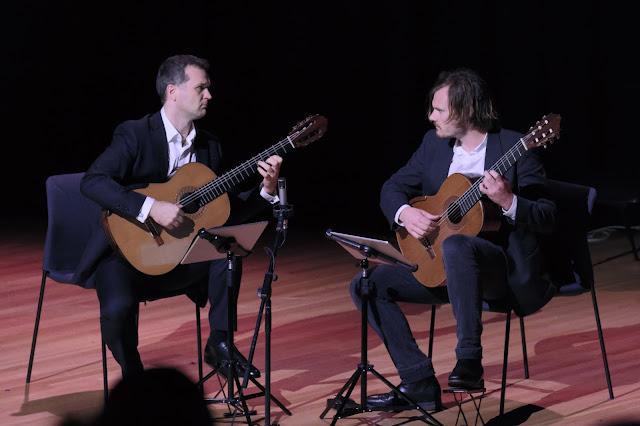 |
| Tammy Gissell - "Mundaguddah" |
National Gallery of Australia - James O Fairfax Theatre
Reviewed by
Bill Stephens
The
penultimate concert in the 2021 Canberra International Music Festival was
devoted to the cultural significance of the Rainbow Serpent among indigenous
peoples and the inspiration provided by the myths surrounding the Rainbow
Serpent for contemporary composers.
Prolific
indigenous songwriter, Joe Geia is admired for his ability to express universal
themes through his beguiling fusion of reggae, rock and funk with indigenous
language and English to create songs with wide cultural appeal.

Joe Geia and the ANU Jazz Collective
For this concert he was joined by the ANU Jazz Collective and offered three songs from his repertoire. Relaxed and comfortable Geia chatted briefly with his audience before performing his alternate version of the National Anthem, which raised more than a few wry smiles. He followed with a gentle love song, “Window Pain”, then after acknowledging his accompanying musicians, finished with a catchy composition entitled “Wanumungu”.

Andrew Blanch - Vladimir Gorbach - "Rain falls and After"
Guitarists
Andrew Blanch and Vladimir Gorbach then took the stage to present the world
premiere of a specially commissioned composition by Christopher Sainsbury
entitled “Rain falls and after”. Based
on a quote from a poem by Melbourne poet, Isobel Robin, the gentle ebb and flow
between the two guitars captured perfectly the ambiance suggested by the words,
“Rain falls and after...a sudden air of mushrooms...and small things moving”.
Brian Howard
composed “The Rainbow Serpent” in 1982 for a performance choreographed by Barry
Moreland and danced by acclaimed Australian ballet dancer Kelvin Coe. It received
only one performance, until reimagined for this year’s festival by indigenous dancer
Tammi Gissell under the title “Mundaguddah – Spirit of the Rainbow Serpent”.

Tammi Gissell performing "Mundaguddah"
Gissell is
an arresting dancer with a strong presence and stunning technique. It was
impossible to tear your eyes away from her as she slithered menacingly around
the stage, inspired by Howard’s complex, atmospheric writing, brilliantly
realised by a superb seven-piece ensemble conducted by Roland Peelman.
It was a
shame however that Gissell’s performance could not have been presented in a
theatrical setting as the presence of the musicians behind her considerably
lessened the impact of her performance.
The eclectic
program completed with “Ngarukuruwala”,
a performance by the Tiwi Strong Women, seven women who sing and dance ancient
traditional songs accompanied by a male Tiwi musician, and performing in front
of a projected image of a painting by Maggie Timapaetua.
 |
| Tiwi Strong Women performing "Ngarukuruwala" |
Barefooted, (although
two of their number wore socks, perhaps in deference the nippy Canberra
weather), outfitted in colourful skirts, and tactfully wrangled by Genevieve
Campbell from the Sydney Conservatorium of Music, the seven women charmed their
audience with their complete lack of artifice.
Often
ignoring Campbell’s attempts at consensus, the group argued unselfconsciously
among themselves, in language, as to what item they would perform next and who
would lead. Once decided, they performed, completely rapt in their songs and
stomping dances, occasionally disagreeing as to which action went with which
words, and seemingly oblivious as to the response of their audiences.
Though fascinating,
even moving, to experience this privileged glimpse into the songs and rituals
of an authentic ancient community, it was difficult to escape the nagging
feeling that by presenting these artists and their traditions in environments
so unsympathetic and alien to their intended purposes, even with the best of
intentions, perhaps these people were being exploited to provide entertainment and novelty
for a privileged few.
Images by Peter Hislop
This review also appears in AUSTRALIAN ARTS REVIEW www.artsreview.com.au